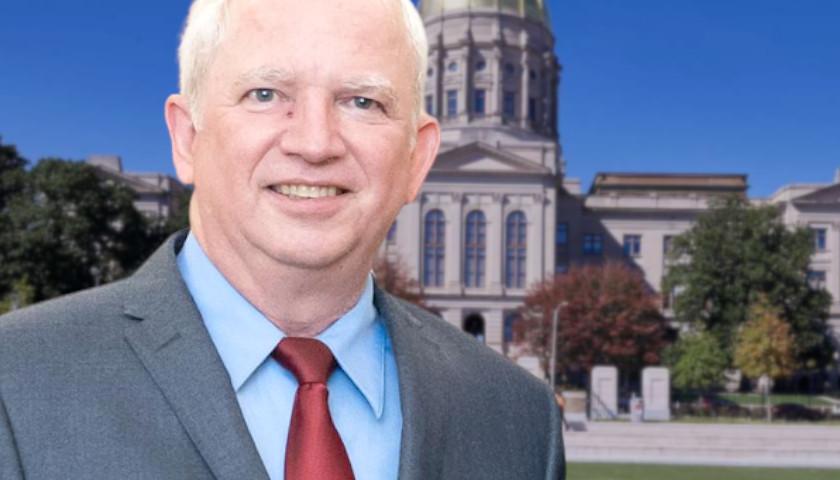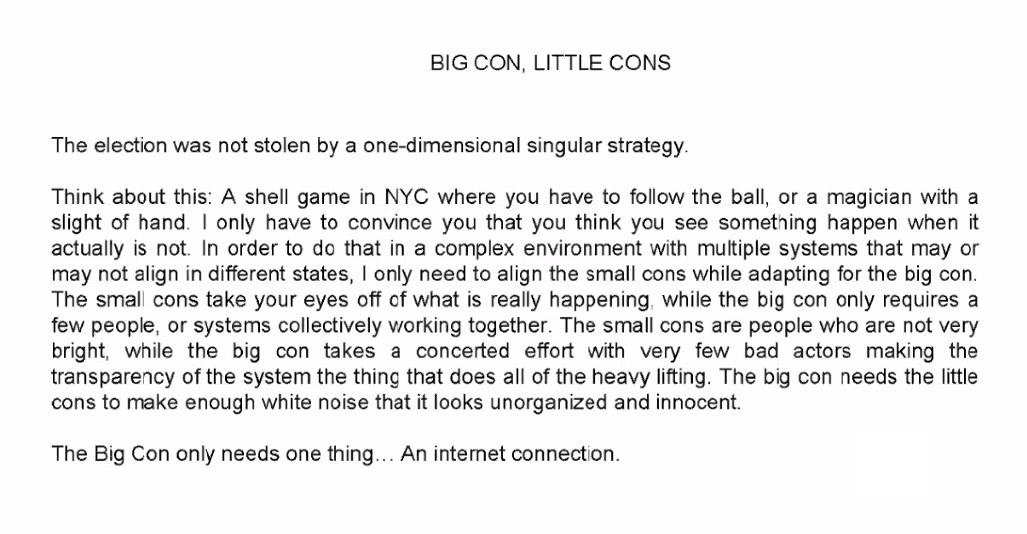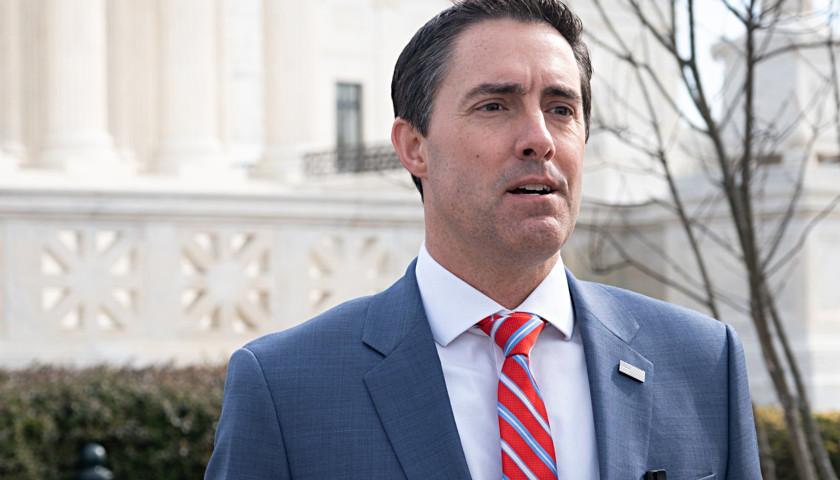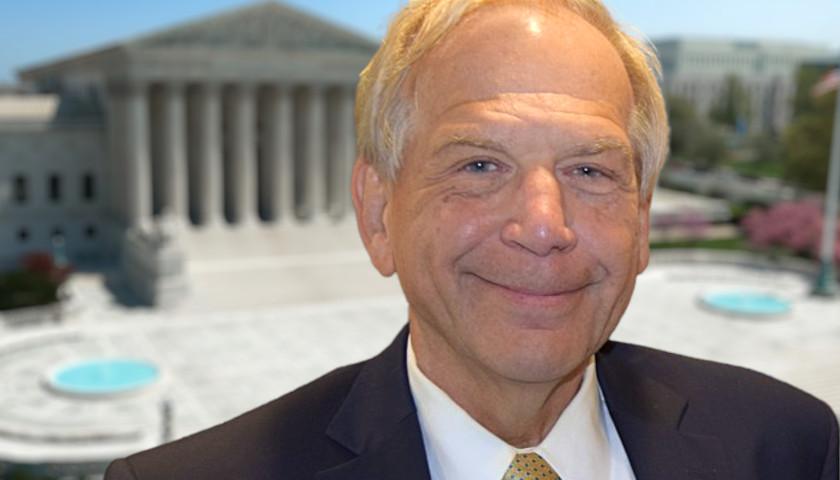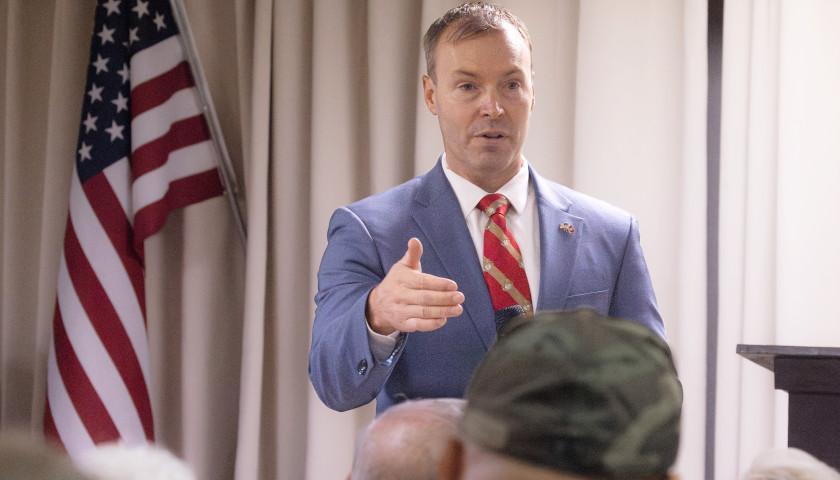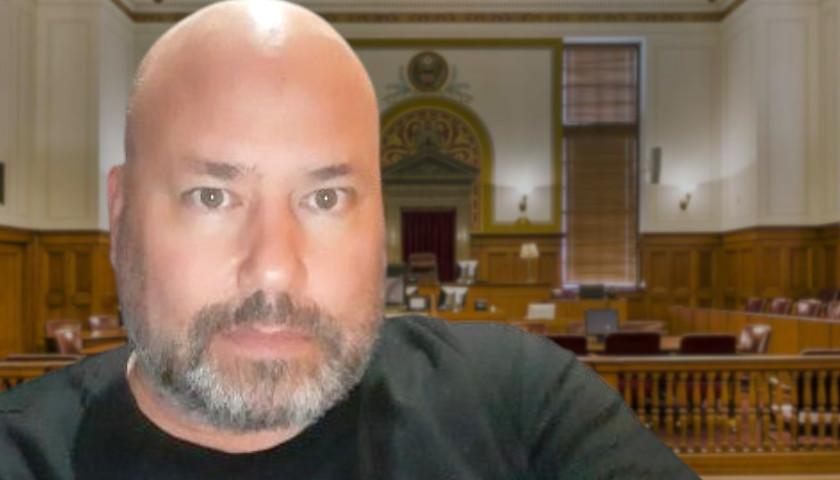The disbarment trial of Donald Trump’s former attorney and constitutional legal scholar, John Eastman, finished a partial ninth week on Tuesday, as the renowned former law clerk for Supreme Court Justice Clarence Thomas explained how he thought fraud occurred in the 2020 election. The State Bar of California is attempting to disbar him over advice he gave Trump and former Vice President Mike Pence regarding accepting electoral slates from states suspected of election fraud.
Eastman’s attorney, Randy Miller, conducted a direct examination of him on Monday and Tuesday, asking him why he believed there could have been tampering with the voting machines, one of the accusations in the California Bar’s charges against him. Eastman (pictured above) said he spoke with two people investigating the election problems on how ballots could be preloaded into the voting machines. One of them, FEC United founder Joe Oltmann, showed him a chart that laid out the points of vulnerability where a rogue actor could manipulate them.
Eastman discussed a memo called “Big Con, Little Cons” that someone investigating election fraud in Georgia had given him, which he found influential. He summarized it as stating that people are getting distracted by small problems when “all that was needed was an internet connection.”
Miller asked Eastman about conversations with key people on January 5, 2021. Eastman said he talked to Oltmann and cybersecurity expert Russell Ramsland that day about their predictions on how election fraud would occur that night in the Georgia run-off election. They predicted as vote totals got close to 100 percent, the percentage reported would remain the same while additional ballots were added. The counting would have to shut down to find voters who hadn’t voted. Eastman said he observed it happen that night in Georgia; the percentage reported stayed at 95 percent for a long time. He said the ballots were either scanned multiple times or the ballot images were replicated multiple times.
Miller reviewed the California Bar’s statements about Eastman in its charging documents. During a speech Eastman gave on January 6, 2021, he said, “We know there was fraud … dead people voting.” The California bar alleged that he knew or was grossly negligent in saying that since it was “false or misleading.”
Eastman pointed out that shortly afterward, in the charging document, the California Bar admitted that the State of Michigan said it found votes from 1,616 people who were deceased on the day of the 2020 election. Only some of them may have cast early ballots and then died.
While the State of Georgia said only four people cast votes who were deceased, Eastman said that still validated his statement. Additionally, he pointed out that Georgia authorities never allowed people to look at the data to determine whether it was accurate or not.
The California Bar’s charges claimed, “Respondent also stated that Dominion voting machines had fraudulently manipulated the election results.” Eastman said he remembers discussing machine manipulation and didn’t name Dominion.
The charges continued, “There was no evidence upon which a reasonable attorney would rely of fraud through electronic manipulation of Dominion voting tabulation machines.”
Eastman said he didn’t describe it as electronic manipulation, pointing out that preloading ballots wasn’t, which is something that could have happened instead, or hacking over the internet. He said he didn’t know if the statements about fraud were true, and to this day, he doesn’t know. He added that experts Garland Favorito and Jeffrey O’Donnell have found evidence of electronic manipulation.
O’Donnell, the CEO of Ordros Analytics, recently published a report on electronic voting machine manipulation called Fingerprints of Fraud. Favorito, co-founder of Voters Organized for Trusted Election Results in Georgia (VoterGA), is a retired IT professional with extensive experience with electronic voting machines and investigating election fraud in Georgia. He testified previously in the trial.
Furthermore, Miller asked Eastman about this accusation: “In fact, respondent knew that on or about November 12, 2020, the Elections Infrastructure Government Coordinating Council and the Election Infrastructure Sector Coordinating Executive Committees issued a joint statement which stated that the ‘2020 presidential election was the most secure in American history’ and ‘there was no evidence that any voting system deleted or lost votes, changed votes, or was in any way compromised.’”
Eastman said that in Michigan’s Antrim County, even election officials admitted votes were switched in the machines between presidential candidates.
On Tuesday, Eastman resumed discussing how he said he believed there was electronic voting machine manipulation. He said there were 5,000 ballots scanned and counted multiple times in the exact same sequences in Georgia, a “statistical impossibility.” He cited the findings from O’Donnell that votes were changed in the machines in Mesa County, Colorado. The California Bar’s attorney, Duncan Carling, objected, saying those audits were hearsay, and California Bar Disciplinary Judge Yvette Roland, who has a history of contributing to Democrats while on the bench, sustained it.
Another accusation the California Bar made was that “No reasonable expert in statistical analysis of election results would conclude that the vote percentages related to the Dominion voting machines indicated that the machines had been used to fraudulently manipulate the election results.”
Eastman said he’d heard there was a 5 percent increase in votes for Joe Biden in counties that used Dominion machines, but he said he did not rely on that particular finding to make his determinations about election fraud.
Miller asked him about a report from VoterGA he’d relied upon, which discovered a 60 percent error reporting rate in Fulton County, Georgia, after conducting a hand count. The report found “923 of 1539 mail-in ballot batch files contained votes incorrectly reported” and “7 falsified audit tally sheets containing fabricated vote totals for their respective batches.”
Also, Miller asked Eastman if this statement by the California Bar was accurate: “On January 6, 2021, before the Joint Session of Congress began, Pence publicly rejected respondent’s proposed plan in a written statement that concluded: ‘It is my considered judgment that my oath to support and defend the Constitution constrains me from claiming unilateral authority to determine which electoral votes should be counted and which should not.’”
Eastman objected and said he had suggested to Pence that he could delay the certification to allow the state legislatures to investigate; he didn’t demand that Pence choose not to count certain votes.
Miller brought up a letter that 64 Pennsylvania legislature members—including the majority of the State Senate — sent to Congress urging members not to accept the certification of their election results. It went over the signs of likely fraud, and concluded, “Requests from legislators for independent investigations have been ignored by the administration. Due to these inconsistent and questionable activities, we believe that PA election results should not have been certified by our Secretary of State.”
Another letter Miller produced was sent by dozens of state legislators from five battleground states on January 5, 2021, to Pence, asking him to delay the certification. It stated in part, “Therefore, we write to ask you to comply with our reasonable request to afford our nation more time to properly review the 2020 election by postponing the January 6th opening and counting of the electoral votes for at least 10 days, affording our respective bodies to meet, investigate, and as a body vote on certification or decertification of the election.”
Eastman discussed the Ryan Report, a letter from several members of the Pennsylvania legislature sent on December 4, 2020, to State Representative Scott Perry (R-PA-10) about the lawbreaking and signs of likely election fraud. The letter said, “The general election of 2020 in Pennsylvania was fraught with inconsistencies, documented irregularities and improprieties associated with mail-in balloting, pre-canvassing, and canvassing that the reliability of the mail-in votes in the Commonwealth of Pennsylvania is impossible to rely upon.”
Eastman said what struck him about that report was that there were 50,000 mail-in ballots returned before they were ever even mailed out. He said he extensively looked into it and determined it wasn’t just people choosing to vote early in person; these were actual mail-in ballots that hadn’t even been printed yet, according to the system.
Miller asked Eastman about a resolution introduced in the Pennsylvania Legislature on November 30, 2020, that went over the signs of likely election fraud and urged state officials to revoke the certification of the 2020 presidential electors. Similarly, he discussed a letter with him that Arizona legislators sent to Pence on January 1, 2021, urging him to delay accepting certification of Arizona’s electoral slate. The letter cited the Court’s refusal to hear the election challenges and review the evidence.
Miller asked Eastman about the testimony and writing of Matthew Seligman, the California Bar’s star witness, who appeared to have an inactive bar license while assisting the bar with its case against Eastman. Bar complaints have been filed against him. Eastman said Seligman didn’t even bother going over the historical Congressional Convention articles, which was a “gross oversight” on his part since they were extremely important due to the debate over who can address disputed electoral slates. Eastman said there was an extensive discussion about the role of Congress during those debates, which revealed that they decided to exclude Congress from deciding disputed electoral slates.
Eastman discussed a 1789 resolution from a joint meeting of Congress, which stated that the vice president opened and counted electoral slates. Roland refused to even grant judicial notice of the document despite the fact it was an official government document from Congress. Next, he went over an 1857 article from The Congressional Globe, which talked about how the vice president decided to accept a disputed electoral slate from Wisconsin and said any objection from members of Congress would be out of order.
Miller asked Eastman to discuss the congressional record from a debate in Congress in 1880 regarding the Electoral Count Act (which was passed a few years later). At that time, Congress discussed the previous presidential elections and came to the same conclusion Eastman did: it is not within Congress’s authority to resolve disputed electoral slates.
A screenshot of the record was displayed, and Eastman explained what it said. He said Congressman Fletcher raised a question and wanted to present an objection. The presiding officer (vice president) said a debate is not in order while the tellers count votes. Congressman Jones of Tennessee asked if it would be in order yet to accept them, and the presiding officer said no. The Congressional Record stated, “The Presiding Officer considers that debate is not in order while the tellers are counting the votes.”
Carling said he intends to bring as his last rebuttal witness Justin Grimmer, who testified earlier in the trial and wrote a paper asserting there was no systemic voter fraud. Eastman said he had three criticisms of Grimmer’s paper.
First, he said Grimmer claimed that an investigation conducted by accountant Bryan Geels included ballots that arrived late, which wasn’t true.
Second, Eastman said the categorization in the Georgia state record is suspect; there are some overlapping categories, and counties say they don’t know sometimes.
Third, and “most significantly,” Eastman said Grimmer admitted that the signature verification rate declined. He said if you only look at the signature verification category, it declined from .28 percent in 2016 to .15 percent in 2020.
Grimmer said that was minor, but it’s a 46 percent decline in rejection rate attributable only to signature rejection.
Eastman said that amounted to 6,500 votes, “more than half the total margin [that Biden won by] in the whole state on just that one issue.”
Eastman added that this decrease in signature verification was caused by the Georgia Secretary of State’s illegal consent decree with the Democratic Parties, which loosened up signature verification requirements. It was illegal since it didn’t have legislative approval, he said.
Roland pushed back and said it is not known that those votes would have gone to Biden. Eastman responded and said the candidates urged voters to vote differently, so there was a 2-to-1 advantage in absentee voting for Biden. Consequently, he said two-thirds of the votes that would have been disqualified would have been for Biden.
Miller brought up a claim by Geels that Georgia Secretary of State Brad Raffensperger asserted was false. Raffensperger said the Geels report claimed that thousands of underage voters were in the 2020 election. Eastman said that wasn’t what Geels’ report said. Geels said the minors had registered to vote before they turned 18, which then made their votes illegal. Geels never claimed they voted when they were minors.
Eastman talked about how Georgia continued counting ballots at the State Farm Arena without observers present on election night, sending them home without telling them they were reconvening, which violated Georgia law, so the votes were counted illegally.
The trial resumes on Monday at 9 a.m. PST. Due to coordinating the parties’ schedules, it is expected to continue sporadically until November 3. Closing briefs will be due November 22. The live stream is here.
– – –
Rachel Alexander is a reporter at The Arizona Sun Times and The Star News Network. Follow Rachel on Twitter / X. Email tips to [email protected].
Photo “John Eastman” by John Eastman Defense Fund.

